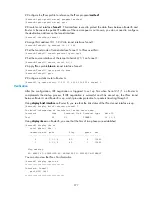
276
# Configure the IPsec profile to reference the IPsec proposal
method1
.
[RouterA-ipsec-profile-atob] proposal method1
[RouterA-ipsec-profile-atob] quit
# Create tunnel interface
Tunnel 1
.
[RouterA] interface tunnel 1
# Assign IPv4 address 10.1.1.1/24 to tunnel interface Tunnel 1.
[RouterA–Tunnel1] ip address 10.1.1.1 24
# Set the tunnel mode of tunnel interface Tunnel 1 to IPsec over IPv4.
[RouterA–Tunnel1] tunnel-protocol ipsec ipv4
# Set the source interface of the tunnel to Serial 2/1/1 on Tunnel 1.
[RouterA–Tunnel1] source serial 2/1/1
# Set the tunnel destination address to 1.1.1.1, the source address of the remote peer.
[RouterA–Tunnel1] destination 1.1.1.1
# Apply IPsec profile
atob
to tunnel interface Tunnel 1.
[RouterA–Tunnel1] ipsec profile atob
[RouterA–Tunnel1] quit
# Configure a static route to Router B.
[RouterA] ip route-static 192.168.1.0 255.255.255.0 tunnel 1
2.
Configure Router B.
# Assign an IP address to interface Serial 2/1/1.
<RouterB> system-view
[RouterB] interface serial 2/1/1
[RouterB-Serial2/1/1] ip address 1.1.1.1 24
[RouterB-Serial2/1/1] quit
# Name the local gateway
routerb
.
[RouterB] ike local-name routerb
# Configure an IKE peer named
btoa
. Because the remote peer obtains the IP address automatically, set
the IKE negotiation mode to
aggressive
.
[RouterB] ike peer btoa
[RouterB-ike-peer-btoa] exchange-mode aggressive
[RouterB-ike-peer-btoa] pre-shared-key simple aabb
[RouterB-ike-peer-btoa] id-type name
[RouterB-ike-peer-btoa] remote-name routera
[RouterB-ike-peer-btoa] quit
# Create an IPsec proposal named
method1
. This proposal uses the default settings: the security protocol
of ESP, the encryption algorithm of DES, and the authentication algorithm of MD5.
[RouterB] ipsec proposal method1
[RouterB-ipsec-proposal-method1] quit
# Create an IPsec profile named
btoa
.
[RouterB] ipsec profile btoa
# Configure the IPsec profile to reference the IKE peer.
[RouterB-ipsec-profile-btoa] ike-peer btoa
















































